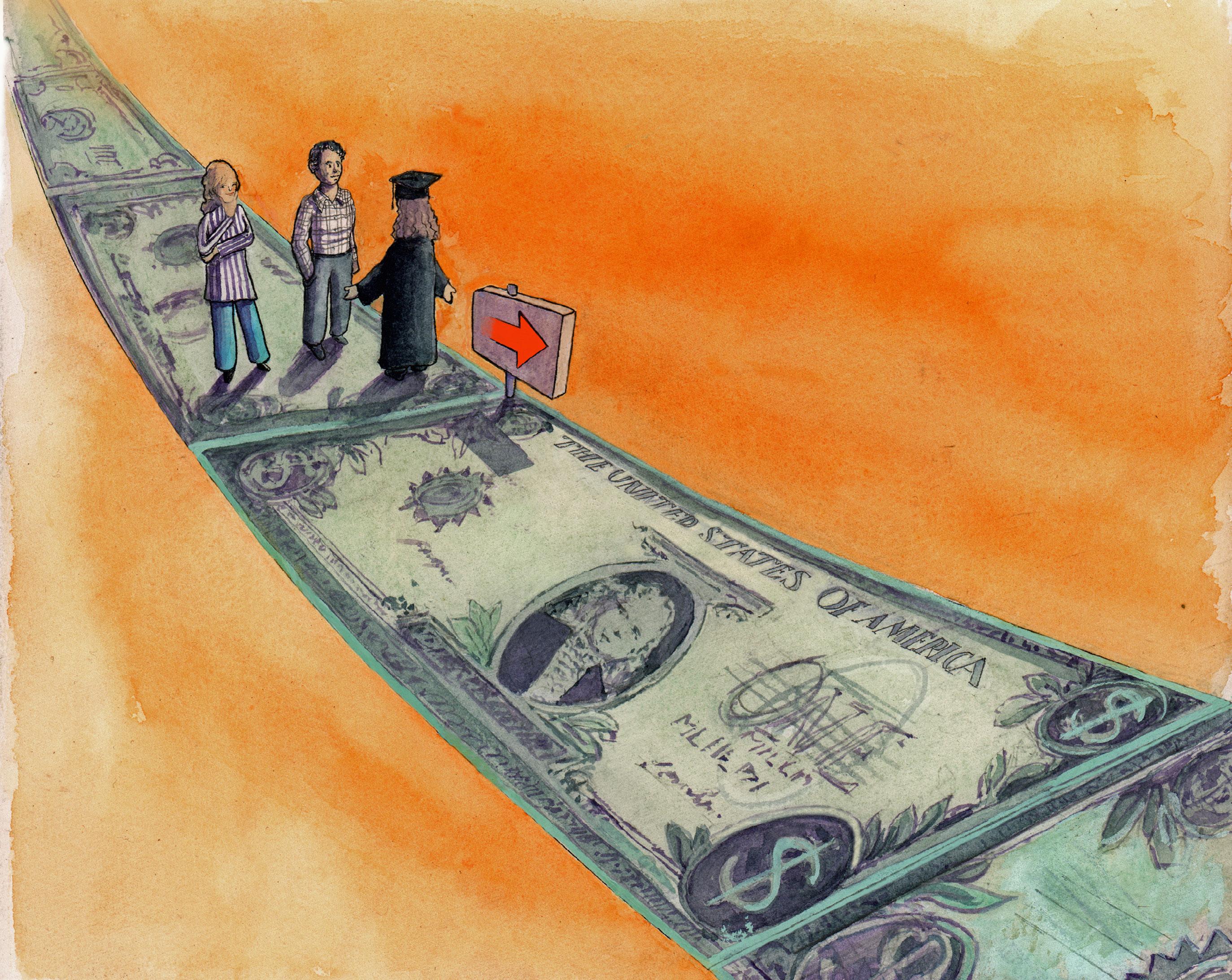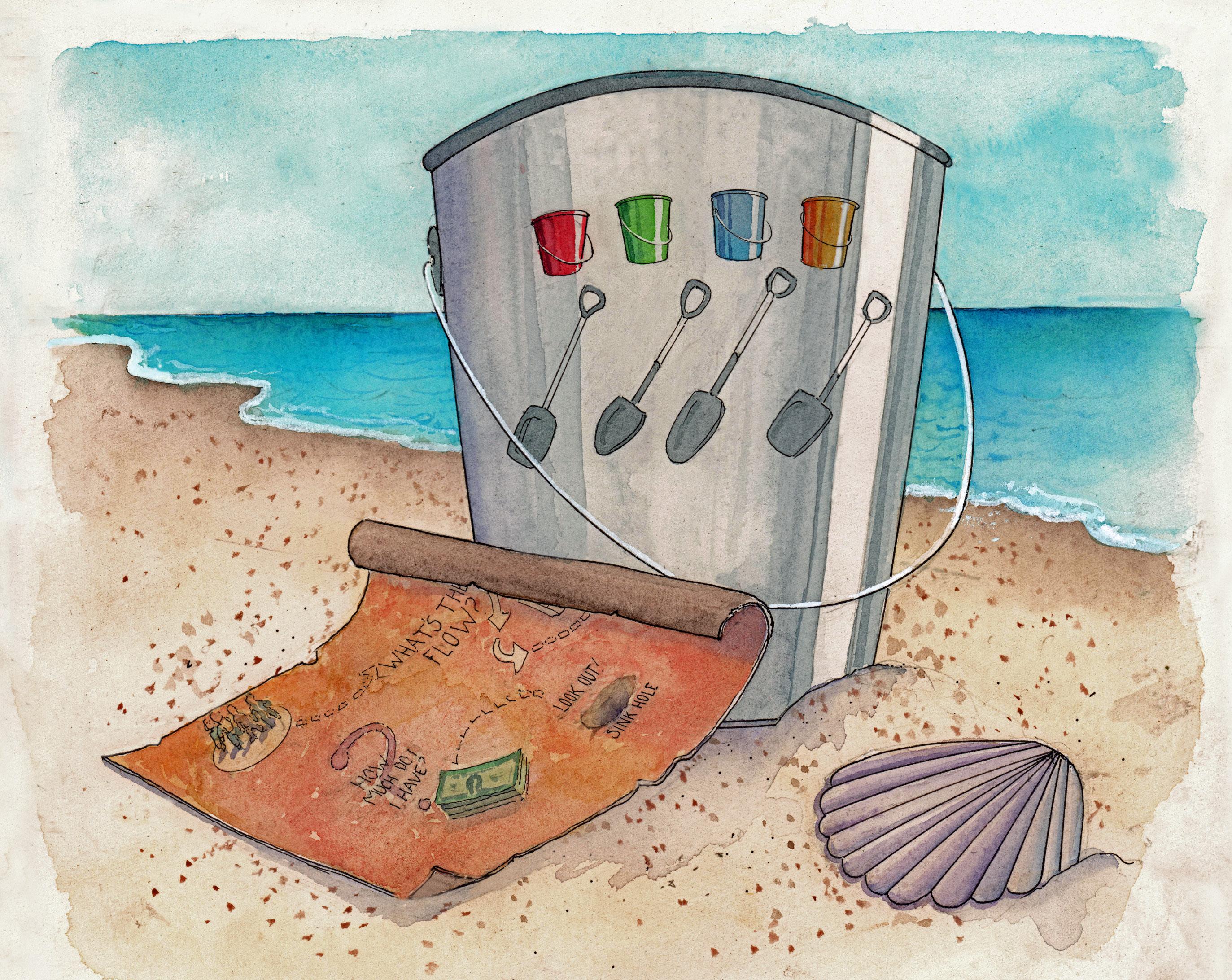
9 minute read
The Shovels Working Together
For the fi nancial plan to work, it requires a lot of teamwork among the four shovels. The scene to the left shows advisors, together with the family, reviewing the map and tweaking the plan as needed . It’s very important to understand that success depends on cooperation to create and then regularly adjust your long term plan .
Let’s look at several features of the illustration:
First, it shows the whole family being involved in the process . Often, parents don’t get their children involved at an early enough age . Of course, this is a family decision, but the right time to start this process is sooner rather than later .
Second, it shows the advisors working together . Too often the advisors work in a vacuum, which causes them to give the client competing and confl icting advice.
Third, there is an empty chair . This represents the rest of the advisors—bankers, real estate agents, consultants— that may be needed from time to time . There should always be room for them .
Fourth, the picture shows everyone using the same map—only one map—and adjusting and tweaking it as life (the beach) dictates .
This combination—the entire family working together with all the advisors on the same map—is a powerful strategy with a high likelihood of success .
~ Part Three: Building Your Own Plan ~
We have now explained the concepts behind 5 Buckets, 4 Shovels, a Beach and a Map. We have discussed popular financial topics that young adults should know. Now, we will give you practical advice and show you how to put these concepts into practice at different stages of your life.
Learning about financial security and applying that throughout your life is a constant development. You will always be changing as will your finances. As you grow, your knowledge of personal finance will grow as well. Don’t be too worried if it seems overwhelming now. For now, here are some steps you can take within the first few years as you begin on your path to financial security.
Keep in mind that everyone’s path is different. The ages in the chart to the left are simply a general timeline. You can, and should, do everything at your own pace and when you see fit. Don’t feel constrained by these specific ages and tasks—they are presented here to help you give a broad picture of what young adults can be thinking about when it comes to personal finance.
~ Adulting Milestones ~
AGES 13-15 AGES 16-18 AGES 19-21 AGES 21-25
Bring up the topic of finances with your parent or guardian Open a personal checking and/ or savings account Adjust your budget according to any new financial situations, like a new job, more expenses, owning a car Add student loans into budget and begin to pay them off
Begin researching banks, credit cards, etc.
Don’t stress—you’re just researching. Create a monthly budget
Figure out if you need to work or get student loans for college
Learn about various insurance policies and what you need
Receive your first debit or credit card
If you are planning on getting a car, begin researching loans
Continue paying off your car loan and building a good credit history
Do your own taxes (where you need to use your W-2, bank documents, college docu ments, etc.)
Invest in the stock market
If you are working part-time, save your W-2 form Start your retirement fund (401k, IRA, etc.) and invest at least 10%
~ What’s Next ~ Things You Should Consider at Every Stage of Your Life and Career
• Make sure you update the plan every year. Some parts of the plan it can be updated every five years.
• If you use credit cards, try to pay off the balance every month. Use the automatic payment option.
• Create a budget of your expected incomes and expenses. The budget should include savings for spe cific goals such as college, a second home, a big vacation.
The budget should have short-term goals, like three years, as well as a long term focus on your needs for retirement funds.
Create an estate plan that designates where your assets go if you and/or your significant other were to die sud denly. Make sure assets are in trusts •
• and things are properly documented. Writing down your wishes to explain the estate plan is a good idea.
If possible, own your home. You build equity every month and in the long run it is less expensive than renting.
Save for retirement every month without fail. If possible, use the Roth feature for retirement funds.
Protect your family with well-thoughtout life insurance policies. Depending on your circumstances, consider both term and permanent insurance. to the benefits received.
• Share your plan with your family (especially your kids) at the appropri ate age.
• Think about non-profits and charities that you can about and the legacy you want to leave behind.
• Don’t live your plan for your heirs, and don’t live your life in such a frugal way that you don’t enjoy the benefits of your hard work throughout your life.
• Use your advisors. No one fills their own cavities or cuts their own hair. Your advisors are there to guide you. Assuming you have the right advisors and your plan is well-coordinated, the cost for advisors is minor compared
Building Your Own Financial Plan
What are the most important aspects of your life right now? Think about friends, family, extracurricular activities, school, work, etc. How will you create your financial plan and budget around these key features?
According to the chart on page 100, what age range are you in? What steps should you be taking right now to en sure your future financial security?
How will you communicate your financial plan to the people who are important to you?
Financial goals are likely to change over time. Earlier in life you might be planning to buy a car, applying for your first credit card or save for college. Later in life, you might be more interested in travel, retirement, and charitable giving. What are your financial goals today, both short term and long term?
What are your interests? Maybe you like to volunteer or want to travel. Putting money aside to fund your interests as well as fun activities, like vacations, should be part of your overall financial plan.
Values play a big part in creating a financial plan that will work for your lifetime. For some people, their family and friends are of highest value; for others, it’s their church and volunteering their time. What are your values?
What is the first tangible step you will take today in order to move your financial plan forward? Examples could be choosing the bank where you will open an account today or figuring out what type of credit card you will apply for. Even if it is a small step, take it!
Use the following pages to map out your next steps, to write an example budget, to figure out your car loans, which stocks to invest in. Your financially successful future can begin here and now!
About the Artist: Richard Sigberman
Born in New York City in 1952, Richard began drawing at an early age and loved it. Rich became serious about fine art and illustration in college, but he is mostly self-taught. He also studied at the NYC Art Students League for 18 months.
business section. Rich was a newspaper illustrator for the Palo Alto Times Tribune from 1983-87, responsible for creating images for the
Since then, Richard has been a free-lance illustrator and fine artist, having created many posters, jazz-oriented art, personal celebration pieces and, most recently, a 25-page sequential art story based on a Nigerian legend. Rich feels that the work he did for Steve Mayer was exemplary in that it combined Steve’s ideas and good writing, with his ability to distill that into images that both illuminate and attract the reader, and makes the copy more inviting. Early on in this project, he told Steve, “I feel I was born to do this kind of art”.
About the Author: Stephen D. Mayer
Stephen D. Mayer was born in San Francisco in 1954, where he attended Riordan High School and then U.C. Berkeley.
A CPA by trade, Steve’s entrepreneurial nature has lead him to be involved in starting more than 18 different busi nesses.
He lives in San Mateo with his wife, Patty, of over 25 years and has three children—Dylan, and twins, Kenzie and Nicola.
Steve is a man of many traditions, including over 40 consecutive years of backpacking with his group of friends. For fun, when he turned 60, he completed an Ironman “because it seemed like a worthy goal.”
Steve also enjoys writing, especially when his experiences can help someone else. This book was written to help fill in the gaps where stu dents are leaving high school without the personal finance knowledge they need to function — basic stuff, like reading a paycheck, filing taxes or getting a car loan. He hopes this will help them understand some of these basic concepts as they move into adulthood.
~ The 5 Bucket 4 Shovel Foundation ~ Supporting Financial Literacy in Young Adults
When we released our fi rst book, 5 Buckets, 4 Shovels, a Beach and a Map, we quickly found that many of our adult clients were handing that book over to their kids to learn a little more about fi nancial security and managing their money . At the same time, we kept hearing about high school students who were entering college without the basic knowledge of personal fi nance. College is a time of great change for these kids—usually moving out on their own for the fi rst time, dealing with students loans and managing their budgets. We knew this group needed help and that we were in a position to provide the help .
The foundation’s mission is to provide fi nancial literacy support for young adults heading into adulthood. All profits from both of our books go directly to the foundation to purchase these books, which are then provided free of charge to schools and young adults . Donations to the foundation also come from our corporate sponsors . All books are available through Amazon .com . Support the foundation at https://www .5buckets4shovels .com/ .


Adulting 101: A Guide to Personal Finance
With over 40 years of industry experience, Steve Mayer takes subjects like reading a paycheck, or doing your own taxes and explains them in an easy-to-read format that young adults can relate to. Personal finance isn’t taught in school, and students are graduating without the basic fundamentals of how to run their lives from an accounting perspective. The goal of this book is to ensure that teens moving toward adulthood have the basic skills they need to make good decisions regarding their personal finances.
This book is provided to young adults free of charge through donations to The 5 Bucket 4 Shovels Foundation, whose mission it is to fund financial literacy for young adults. Through the sale of our other two books, 5 Buckets, 4 Shovels, a Beach and a Map, and The Toughest Guy I Ever Knew and Other Short Stories, both available through Ama zon.com, all profits go directly to the foundation to fund the mission. We also receive donations directly through our relationships with our corporate sponsors.
Our hope is that Adulting 101: A Guide to Personal Finance will easily become the go-to reference book for young adults looking for basic information about personal finance. Many of SD Mayer & Associates clients provide this book to their own kids and find it to be very helpful in explaining these basic concepts.










